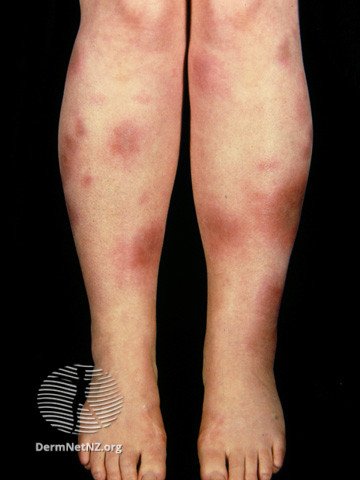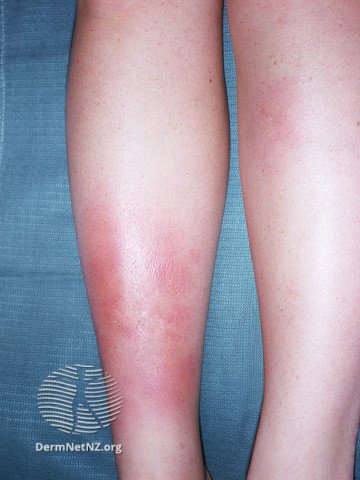
Erythema Nodosum
Erythema Nodosum presents as inflamed, tender nodules, usually on the lower legs.
Credit: DermNet NZ
What is erythema nodosum?
Erythema nodosum (EN) is an inflammatory skin condition that presents as tender, red, raised nodules, primarily on the shins. It represents a type of panniculitis, meaning inflammation of the subcutaneous fat. The exact cause of this condition can vary, but often it may be linked to another underlying health issue or remain unidentified.
What causes erythema nodosum?
Several factors and conditions can trigger erythema nodosum. In general your dermatologist will check bloodwork and do a thorough history and physical to assess for these.
Infections: like streptococcal infections, tuberculosis, and some fungal infections
Medications: such as oral contraceptives, certain antibiotics, and some anti-tuberculous drugs
Autoimmune diseases: for instance, inflammatory bowel disease or Behçet's disease
Pregnancy
Internal Conditions: like sarcoidosis and some malignancies
Unknown causes in many cases
What are the symptoms of erythema nodosum?
The primary symptom of erythema nodosum is the appearance of painful, red nodules on the shins. Other characteristics and symptoms include:
Nodules' size: ranging from 1 to 5 cm
Color change: nodules transition from red to purple and then brownish-yellow as they age
Joint pain: often in the ankles, knees, and wrists
Accompanying symptoms: such as fever, fatigue, and malaise
Resolution: nodules usually resolve without scarring over 3-6 weeks
How do I treat erythema nodosum?
Treatment for erythema nodosum aims to relieve symptoms and address any underlying cause:
NSAIDs: like ibuprofen for pain and inflammation
Potassium iodide: for certain cases when other treatments don’t work
Corticosteroids: used in severe instances or when related to specific conditions
Addressing root cause: like treating an identified infection or discontinuing a triggering medication
Rest and leg elevation: to alleviate discomfort and swelling
How do I prevent erythema nodosum?
Prevention methods for erythema nodosum involve:
Medical check-ups: particularly if associated with ongoing conditions like inflammatory bowel disease
Avoiding medications: that are known or suspected triggers
Immediate treatment of infections: to prevent erythema nodosum in susceptible individuals
Rarely, erythema nodosum can also affect the arms.
Credit: DermNet NZ
In severe cases, erythema nodosum can be mistaken for cellulitis.
Credit: DermNet NZ



